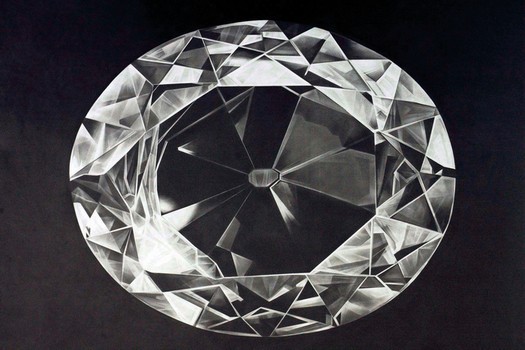Serse
25 Oct - 01 Dec 2007
SERSE
"Diamonds"
The art of Serse Roma may well seem approachable through mere observation. Many of his works refer clearly to the well-known traditional genres of landscape or still life. They therefore offer a figurative, realistic shape, emphasized by the use of black and white and nuances of grey, with a direct reference to photography. Serse uses lights and shadows as a means to capture his subjects, whether they are a landscape, a blanket of clouds or an object such as a simple paintbrush. His technical vision of drawing aims at reaching the illusion of perfection, that in practice is a method to investigate the image and its actuality. In the inertia of his drawings – slowness pervades both the creative process and the works themselves – Serse finds an opportunity to investigate the liveability of his images and the intrinsic qualification of their caducity. At a time when the opportunity to think or talk about images is overcome by the rate at which they are produced, Serse opts for the stillness of metaphysics, the silence of the unspeakable. His works incorporate our experience of his subjects. Their immensity flares up, finds an echo, because their presence in time is translated into the meticulous process of drawing.
Yet the drawings do not easily allow for the definition of images.
The surface tension of water in a wave, a monumental mountain or a vertical paintbrush mean to Serse a starting point from which he can investigate the current meaning of a means. He is aware of the fact that he himself and his works find themselves in a wide field, between photography and painting. His works share with photography the documentary and the ordinary, the flat surface, its accuracy and bright scientific recording. This is the reason why his art places itself in the present time: it accepts the parameters of the current perceptive framework.
Serse’s work shares with the pictorial tradition the frailty of the matter and, as a consequence, its vibration, rhythm and lightness, that ultimately means sharing the possibility – or the unavoidability – for intuitive observation. Serse enters history and the pictorial tradition. He relates himself both to the sublime of the works of Caspar David Friedrich and to the metaphysical stillness of the works of Giorgio Morandi.
"Diamonds"
The art of Serse Roma may well seem approachable through mere observation. Many of his works refer clearly to the well-known traditional genres of landscape or still life. They therefore offer a figurative, realistic shape, emphasized by the use of black and white and nuances of grey, with a direct reference to photography. Serse uses lights and shadows as a means to capture his subjects, whether they are a landscape, a blanket of clouds or an object such as a simple paintbrush. His technical vision of drawing aims at reaching the illusion of perfection, that in practice is a method to investigate the image and its actuality. In the inertia of his drawings – slowness pervades both the creative process and the works themselves – Serse finds an opportunity to investigate the liveability of his images and the intrinsic qualification of their caducity. At a time when the opportunity to think or talk about images is overcome by the rate at which they are produced, Serse opts for the stillness of metaphysics, the silence of the unspeakable. His works incorporate our experience of his subjects. Their immensity flares up, finds an echo, because their presence in time is translated into the meticulous process of drawing.
Yet the drawings do not easily allow for the definition of images.
The surface tension of water in a wave, a monumental mountain or a vertical paintbrush mean to Serse a starting point from which he can investigate the current meaning of a means. He is aware of the fact that he himself and his works find themselves in a wide field, between photography and painting. His works share with photography the documentary and the ordinary, the flat surface, its accuracy and bright scientific recording. This is the reason why his art places itself in the present time: it accepts the parameters of the current perceptive framework.
Serse’s work shares with the pictorial tradition the frailty of the matter and, as a consequence, its vibration, rhythm and lightness, that ultimately means sharing the possibility – or the unavoidability – for intuitive observation. Serse enters history and the pictorial tradition. He relates himself both to the sublime of the works of Caspar David Friedrich and to the metaphysical stillness of the works of Giorgio Morandi.

